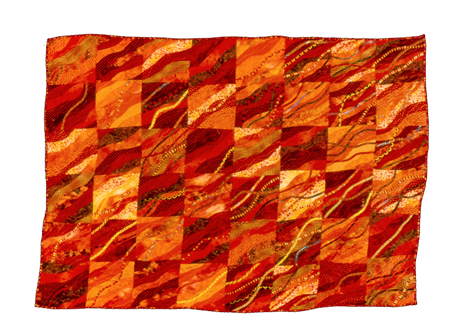Kathy Loomis’ blog today referred a reader to her 2010 tutorial on piecing very narrow lines into a background fabric, which for some time have been a feature of her work. She’s not the only one who pieces narrow at times – Lisa Call , Margery Goodall and Alicia Merrett are among other well known quilt artists who produce great effects with very narrow lines pieced in. I know Margery well but have never watched her doing her machine piecing; Kathy described her process in that post; and I have no accurate knowledge of the steps Lisa and Alicia use or in which order, but I would say that they all do the cutting and piecing in different order, and perhaps even with different equipment, as none of their works look like the other – and nor do they look like mine, either!
When I first started to insert strips years ago, I worked out how to get them VERY even, parallel, usually about 1/2″ showing on front, but worked down to narrower strips after a time, as in “Strip Lighting” 1990 – the strips range from 1″, 3/4″ , 1/2″to 1/4″
Ora Banda 1992 (below L) and Window Onto Bougainville Street 1992 (below R) are early examples, and you can find full views of these two in my Colour Memories gallery on this website. With straight cuts into the background fabric, strips cut exactly parallel, and carefully followed seam allowances, the result is predictable, and was pleasing at the time.
I eventually worked out how to avoid the dreaded bias cuts AND achieve a fair bit of curve using straight cuts from selvedge to selvedge, and it doesn’t even matter if the lines are a little uneven !! Why? Because, as long as there’s enough seam allowance, the main secret is that for the second seam I turn the work over and sew that line from the other side, that is, with the strip lying on the sewing table, beneath the background fabric.
In 1991 I discovered that even straight strips will curve very nicely with proper handling, a learning process that began while making ‘Lilydale’. I was in hurry to meet a self imposed deadline, and had trouble with some cuts that came out unexpectedly a bit off, but some of those fabrics were fat 1/4’s of which there wasn’t any more to piece in – so with necessity being the mother of invention, I learned how to manage slightly curved inserts!
Eventually I incorporated more pronounced curves with strips, with a good example being Bushfire 4 (2004) but there are many more in the Colour Memories gallery. The strips in each are all cut selvedge to selvedge, really, there are no bias strips; and my piecing is as good and flat as anyone’s, anywhere. These strips were cut about 3/4″ and appear on the front as something less than 1/2″.
To make straight strips combine with curves, though, needs a workshop with hands on demo, and plenty of practice – is is a little more complicated, but it’s not hard. It took me a while to work out how far I could push the degree of curviness, but ask me to teach in your area and I’ll come and show you what I learned!
………………………………….
2003 marked a new phase of inserts – with an organic look, often very skinny, too; but its still the same that once you get to sew – the sew-the-second-seam-from- the-back-thing still applies. This is ‘Lightstream’
and it led to the group of quilts I now label the Ebb & Flow quilts – gallery on this website with plenty of examples.









